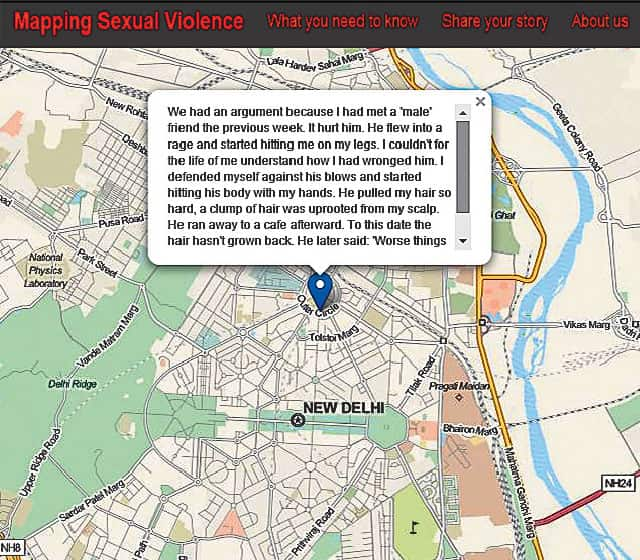New website makes a statement by plotting stories of sexual violence
Three women have come together to create a platform where women, men and transgender individuals can cathartically 'report' these incidents on an interactive map, view real-life stories posted by others, and eventually access resources that will help them seek counselling or take action against the perpetrators, if they wish to do so.
Maybe as a child you were felt up by your tailor or your breasts were groped by a stranger at a railway station. Or perhaps you were assaulted or raped by a boyfriend, a friend, or a relative. Most women in India have an incident of sexual abuse locked inside them, which they either hesitate to tell, or dismiss as part of the vagaries of growing up.

Three women have now come together to create a platform where women, men and transgender individuals can cathartically 'report' these incidents on an interactive map, view real-life stories posted by others, and eventually access resources that will help them seek counselling or take action against the perpetrators, if they wish to do so.
The website is called Mapping Sexual Violence (mapping-sexual-violence.appspot. com) and, in the two weeks since it was launched, six incidents have been posted from across four Indian cities and Muscat, Oman.
The initiative was an extension of a special issue on sexual violence of the literary journal Out Of Print, and was the brainchild of poet and guest editor Meena Kandasamy, author and guest editor Samhita Arni, and founding editor Indira Chandrashekhar.
"It's my personal experience of sexual abuse that led to my interest in this issue," says Arni, 30, author of the acclaimed Sita's Ramayana.
Adds Kandasamy, 30: "There is a culture that exists in a state of perpetual denial, maintaining that rape and/or sexual violence are something that happens elsewhere and to other people. There is also a section of the population that says, 'It is too commonplace', and lapses into a complacence and a silence about it, instead of being outraged."
The aim of the website is to mobilise that outrage, on a personal and a collective level.
“The dialogue that begins in such spaces can potentially generate a movement that will change mindsets about gender roles and about the impunity of sexual predators,” says Chandrashekhar.
IN OTHER WORDS…
Hold your cursor over the locator balloons that mark the individual stories on Mapping Sexual Violence and the statistics we are all so familiar with come alive.
These are ‘regular women’, haunted by incidents strikingly similar to the ones reported every day in the newspapers. Suddenly, the knowledge that there are millions like them becomes a less distant, more urgent reality.

An anonymous report describes an incident of violence within an abusive relationship, mapped in the heart of New Delhi.
“I don’t think everyone realises how pervasive it is — and that’s because we don’t talk about it, as a consequence of which we don’t report it,” says Arni. “And then they say that the incidence of sexual violence in India isn’t as bad as, say, in Sweden, if you adjust for population size. But because we don’t talk about or report these incidents, the statistics have no way of accurately reflecting how endemic this violence is.”
The balloons serve a very distinct purpose. “We need to see how sexual violence occupies the same spaces that we use every day,” says Chandrashekhar. “It may also help us comprehend how space and violence interact — how place, context and infrastructure can either aid or prevent acts of sexual violence.”
The next step will be to make the site available in regional Indian languages and turn it into an active element in the fight against sexual violence.
“We are in conversations with organisations such as Asia Society and G5A to help generate resource networks for help centres, lawyers and aid organisations, links to which we will feature on the website,” says Chandrashekhar.
Adds Kandasamy: “Through this site, what outrages us will reach the ears of those who are selectively deaf.”
"About 90% of all sexual violence takes place within the family and there needs to be an awakening on that subject. Mapping sexual violence has the potential to make all violated women feel connected and heard, their experience validated," says Rashna Imhassly-Gandhy, psychologist and author.





